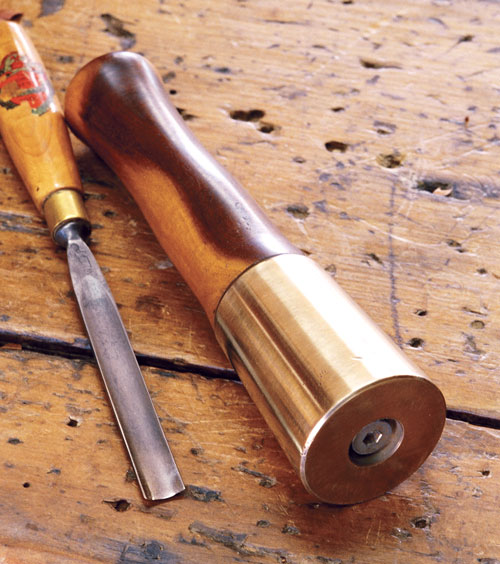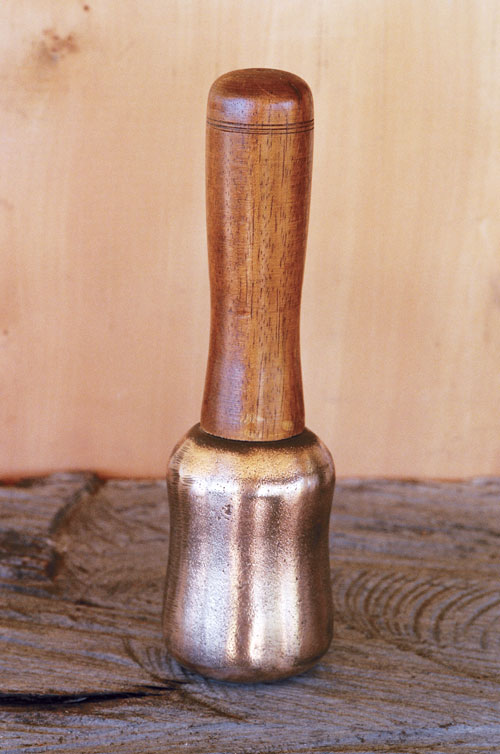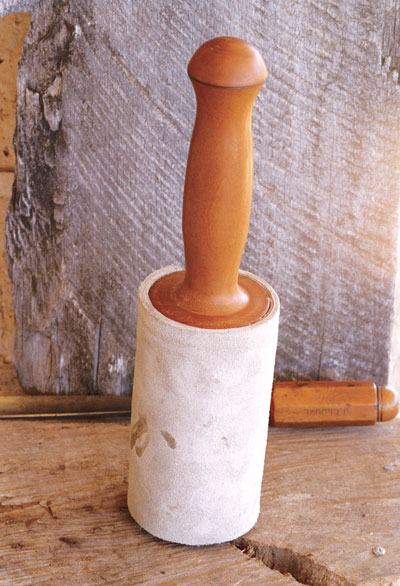The woodcarver’s mallett
‘I have a large collection of mallets, but I think two are sufficient…’, says Donald Powell.
Words and photos: Donald Powell
The carvers mallet is an ancient tool dating back to Greek, Roman and Egyptian times. A tool used to drive a chisel into the material being carved. Carvers in wood and stone developed their sculptures over the ages with the use of the mallet and chisel. Archeological excavations and the evidence found on ancient sculptures bear this out.
The head of the carver’s mallet is round so its face always strikes the handle of the chisel, no matter what the position of the chisel. This position can constantly change as the carver works the chisel over the surface of his carving in a variety of angles.
The chisel will be less likely to be driven in the wrong direction if a mis-hit occurs as the round head of the mallet will glance off the chisel handle. It is best if the mallet is flat on the top to allow it to be stood upright when not in use. If the mallet is laid on its side, sooner or later it will surely roll off the bench. Apparently it has a homing device directing it onto your foot.
During the first half of the last century in the western world the large majority of carvers were professionals who carved as a trade. I remember reading of one old carver who liked the face of his mallet to break down to a fuzz which he claimed was less likely to glance off the chisel handle when mis-hit, and also better absorbed the shock of the strike.
Preferred woods
In Europe, apple and beech were popular choices for carver’s mallets. Lignum vitae, a hard and dense wood which provides weight without too much bulk, was another favourite. In the US, hickory was also used.

1. Mallet made of lignum vitae.
I have always fancied a lignum mallet made from an old lawn bowl. I did find an unusual source of lignum that I converted into a mallet head. Oval-shaped with a hole through the centre, it was originally used on the rein of a delivery draught horse, being dropped to the side of the road to check the horse and cart while a delivery was made. I fitted it with a jarrah handle to make a very good mallet, even though there is some sapwood (photo 1). Lignum sapwood flakes can be razor sharp so beware.
Turned mallets

2. Turned from dead finish, a very hard Australian inland wood.
One-piece mallets turned from a block of wood are easy to make. Some years ago I had one made to my design in dead finish by Graham Newman in Maryborough (photo 2). Mine was sized for heavy work, but he made a variety of sizes and weights. They were so outstanding that some were bought by collectors and never struck a blow. Mine however has been subjected to a real battering over the years, although the wood is so hard that the strike face has barely the trace of a dent.
I have used lignum, plum, beech, kwila, camphor laurel, gidgee and mulga satisfactorily for mallets. Although they all make fine mallets when turned from one suitable block, it is better to fit a separate handle. I believe that this style better absorbs the shock of the mallet blow. The mallet head can also be shaped so that the grain runs across the head, allowing two faces of endgrain. A finger groove can be added to the handle to act as a guide when picking up the mallet so that the endgrain is presented to the chisel handle.
Leather and metal mallets

3. US-made leather-workers mallet
There are several alternatives to the traditional wood mallet. Leatherworkers mallets used for leather stamping are available from the US (photo 3). Crafted in a range of sizes with a solid plastic head, they have well-made leather handles in the style of sheath knife handles. These are built up with washers of leather shaped to fit the hand comfortably and fitted with a brass pommel. I have used one and found it well-balanced and good to grip. The finely serrated head provides a non-slip surface and does not have the unpleasant bounce of plastic. It has sufficient mass to produce a solid strike and absorbs shock well.

4. Brass mallet with gidgee handle, secured by screw in top.
The soft metal head mallets of the stonemason have become quite popular amongst woodcarvers and their small size allows them to fit compactly into a carver’s kit when travelling. I have three, including one turned in brass with a tapered head (photo 4).

5. Cast bronze mallet made by John Strachan.
This taper helps the face of the mallet strike the handle of the chisel squarely. I also have a very good bronze mallet (photo 5) made by John Strachan, a metal caster.

6. A metal mallet made by Phil Ashby.
My other brass mallet was crafted by Phil Ashby in the baton style and has a brass cylindrical head fitted to a walnut handle (photo 6). It is nicely weighted and good for very deliberate work.
These types of soft metal mallets are very good for lighter duty work with the metal head palmed rather than swung by the handle. They are very comfortable to use in this manner and can be used to great effect and quite delicately.
Using mallets
When choosing a mallet, don’t opt for one that is too heavy. Lift the mallet to try its weight and remember you will be using it for lengthy periods of time. A mallet that is too heavy will quickly tire you out.

7. Leather wrapped mallet
Some carvers are sensitive to the transmitted shock of the mallet strikes to their joints, muscles and tendons. I have seen carvers frustrated by tennis elbow. Some carvers mallets are coated with layers of tape to absorb shock, but I have found the most successful method to be wrapping and gluing heavy saddle leather around the face of the mallet, flesh (suede) side out. This is a great shock absorber, has a nice strike feel, and not being slippery helps to eliminate mis-hits (photo 7).
When using the mallet, if possible you should be standing with feet apart, properly balanced and weight evenly distributed. Try to develop a steady rhythm with a constant force. Don’t use the mallet with chisels with tight bends in the shaft as tool breakage will likely result.
I am not a carver who uses a mallet all the time, but for heavy roughing out and working in hard woods a mallet is essential. Sometimes the heel of the hand is used in place of the mallet, but sparingly. I always think of those carvers from yesteryear who used this practice constantly over their working life, damaging the tendons and ligaments of the hand and causing a deformity known as ‘carver’s claw’.
Mallet handles should not be too thick as this can be very tiring on the hand. I like a pronounced swell on the base of the handle to prevent the mallet from slipping, and I like the top of the hand to fit snugly into the base of the head of the mallet.
Having said all this, I do have a large collection of mallets which I enjoy owning and using, but I think two are sufficient: one very large wood mallet for the larger tasks and a small metal one for the lighter more delicate work.
Learn more about Donald Powell here



